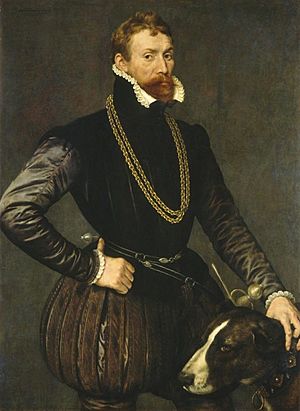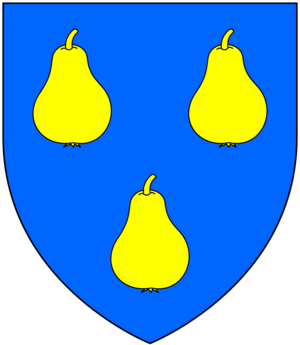Thomas Stukley facts for kids
Thomas Stucley (around 1525 – August 4, 1578) was an English adventurer and soldier. He was also known as the Lusty Stucley. He fought in France and Ireland. He also took part in the famous Battle of Lepanto (1571). He died fighting in the Battle of Alcazar in 1578 against the army of Morocco. Thomas Stucley was a Catholic who did not support the Protestant Queen Elizabeth I.
Contents
Family and Early Life
Thomas Stucley was a younger son of Sir Hugh Stucley (1496–1559). Hugh was the lord of the manor of Affeton in Devon. Their family was old and well-known. His father was a special knight to King Henry VIII. Thomas's mother was Jane Pollard. Her father, Sir Lewis Pollard, was a judge.
Some people believed that Thomas Stucley might have been an unofficial son of King Henry VIII. We don't know much about his own wife or children.
An Adventurous Career
Thomas Stucley learned from important people early in his life. He was at Boulogne during a big battle in 1544–45. He was a standard-bearer (someone who carries a flag) there from 1547 to 1550. Later, he worked for Edward Seymour, 1st Duke of Somerset. When his boss was arrested, Thomas had to escape to France. He then joined the French army.
His skills in battle caught the eye of French leaders. He was sent to England with a letter for King Edward VI of England. In England, he told the King about French plans to capture Calais. He also spoke of a plan to attack England. However, he was put in the Tower of London for a few months.
After being released, Thomas had money problems. He had to become a soldier who fought for money (a mercenary). He returned to England in 1554. He married Anne Curtis, who was wealthy. But he spent money very quickly. Soon, he had to leave England again. He joined the Duke of Savoy's army. He fought in the Battle of St. Quentin in 1557.
In 1558, Thomas was questioned about attacking ships at sea. But he was found innocent. He remained popular with Queen Mary I of England. When Queen Elizabeth I came to power, he gained more money. He became a supporter of Sir Robert Dudley, Earl of Leicester. In 1561, he became a captain in Berwick. He became good friends with Shane O'Neill, an Irish leader.
Thomas Stucley once told Queen Elizabeth that he wished to be a ruler of even a small place. He felt he would become a prince one day. The Queen joked, "I hope I shall hear from you when you are installed in your principality." Thomas replied that she surely would, "In the style of princes, to our dearest sister."
The Florida Plan
Stucley then thought of a plan to start a new English settlement in Florida. At that time, Spain and France were also trying to settle there. He convinced Queen Elizabeth to give him a ship and 100 men. He also had five of his own ships. After showing off his fleet on the River Thames, he sailed to Ireland in June 1563. He planned to attack French, Spanish, and Portuguese ships.
Other countries complained to Queen Elizabeth. She said she did not support Stucley's actions. She sent a navy force to arrest him. One of his ships was captured. Stucley surrendered but was found innocent again. His friend Shane O'Neill helped him.
Adventures in Ireland
His meeting with O'Neill made Stucley interested in Ireland. Queen Elizabeth recommended him to the English leader in Ireland, Sir Thomas Radclyffe. In 1566, Stucley worked as a captain for Sir Henry Sidney. He tried to get O'Neill to talk with the English government. Sidney wanted Stucley to buy land and an important job in Ireland. But Queen Elizabeth said no.
Stucley later bought land in County Wexford. He was given a job there, but the Queen disagreed. In June 1568, he lost his job. He was later held in Dublin Castle for 18 weeks. This was because he had disagreements with officials and supported some local leaders.
Journey to Spain
Stucley was found innocent again and released in October 1569. He was suspected of suggesting to King Philip II of Spain that Spain should invade Ireland. Soon after his release, he offered his help to the French ambassador in London. He returned to Ireland in 1570. He prepared a ship in Waterford. He then sailed from Waterford on April 17. His real goal was Vimeiro, Portugal.
King Philip II invited him to Madrid, Spain. He was given many honors. He was known at the Spanish court as the "Duke of Ireland". He was given a nice home and money near Madrid. This was likely to make Queen Elizabeth worried about an invasion of Ireland.
In 1570, there were rumors that Stucley wanted to be part of a plot to attack Ireland. This attack would have happened during a planned invasion of England. An English spy, Oliver King, told the English government about Stucley's plans. Stucley tried to have King arrested in Spain. But Queen Elizabeth demanded Stucley's removal from Spain.
Fighting for the Pope
Stucley then moved to Rome. He became friends with Pope Pius V. The Pope had removed Queen Elizabeth from the Catholic Church in 1571. Stucley was given command of three ships at the Battle of Lepanto on October 7, 1571. He fought very bravely. This was a big victory for the Holy League against the Ottoman Empire. It helped Spain focus more on its fights in northern Europe.
Stucley's bravery made him popular in Madrid again. By March 1572, he was in Seville. He offered to protect the seas against the English with 20 ships. He received a lot of money from King Philip II of Spain. But he grew tired of the King's delays. He sought help from the new Pope, Gregory XIII. The Pope wanted his son to become King of Ireland.
Plans in Rome
Stucley joined forces with another Irish leader, Fitzmaurice. He moved to Rome in 1575. He was said to walk barefoot in the streets and churches. In June, Stucley met his old commander, Don John. They talked about plans for an expedition to England in October. The goal was to free Mary, Queen of Scots, from prison and take over England. Don John thought 3,000 men were not enough.
In 1575, a friar named Patrick O'Healy came to Rome. He said the King of Spain supported an Irish gentleman who wanted to start a revolt. Pope Gregory said that the Irish crown should go to a native Catholic, like Mary, Queen of Scots. He did not want a French or Spanish ruler. The Pope was willing to pay for 200 men to go to England. He wondered if they could try to capture Queen Elizabeth. Later, it was suggested that 5,000 men go to Liverpool to free Mary.
English spies were sending news about Stucley's plans back home. In 1572, Oliver King told London about invasion plans. In 1573, Queen Elizabeth's spy master, Lord Burghley, heard that some "gentlemen" would join Stucley in Spain. In 1575, there was news of Stucley's alliance with Fitzmaurice. In 1578, more similar news came.
The Final Expedition
On October 1, 1578, Don John died. His death changed the plans for invading England. But there was still support for helping the Irish. In 1576, Fitzmaurice was welcomed in Rome. A plan was presented to the Pope to invade England through Liverpool with 5,000 soldiers under Stucley's command.
In 1578, the Pope gave Stucley soldiers. Stucley set out with 2,000 fighting men. These soldiers were led by professional officers. Stucley's army grew to 4,000 men.
Stucley sailed for Ireland from Civitavecchia in March 1578. In April, he reached Cadiz with ships that were falling apart. He gave special travel papers to Irishmen going home. He called himself the Marquess of Leinster, a title given by the Pope. King Philip II sent him to Lisbon. There, he was supposed to meet Fitzmaurice and get better ships for Ireland.
In Lisbon, King Sebastian of Portugal asked Stucley to join his army. The King was planning to invade Morocco. Stucley decided to abandon the Irish invasion. He joined the Portuguese king's army instead. He reportedly said that Ireland only had "hunger and lice."
Other members of the expedition, including Nichola Sanders, went back to Rome. They continued the Irish invasion plan, but it was now much weaker without Stucley's men and money.
When they landed in Morocco, Stucley disagreed with the plan to march against a large Moorish army. He also criticized the Portuguese king's soldiers. He reportedly fought bravely on August 4, 1578, at the Battle of Alcácer Quibir. He commanded the center of the army. He was killed early in the battle. Some stories say his own Italian soldiers killed him after the Portuguese were defeated.
Legacy
Thomas Stucley's life made a big impression on people at the time. Even after his death, people talked about him a lot. A play called The Battell of Alcazar with the Death of Captain Stukely was printed in 1594. It was probably performed in 1592. It tells the story of Stucley's arrival in Lisbon and his journey to Morocco. In the play, he talks about his life before he dies.
Another play, The Famous History of the Life and Death of Captain Thomas Stukeley, was printed in 1605. This play tells about different parts of his life. His adventures also became the subject of many songs and poems.



